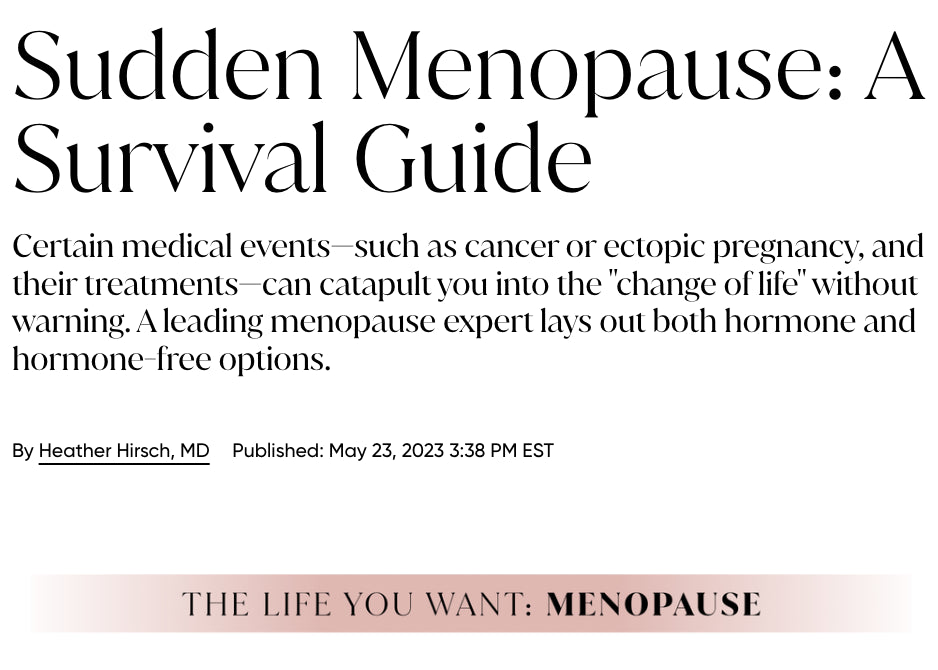Sudden Menopause: A Survival Guide by Heather Hirsch, MD for Oprah Daily
Women experience sudden menopause for a variety of reasons. They include having chemotherapy or radiation treatments for cancer, which can cause ovarian failure/ dysfunction, or surgical loss of both ovaries during procedures related to ectopic pregnancy, endometriosis, ovarian cyst removal, or ovarian cancer. Sometimes the onset of sud den menopause happens when women decide to have both of their ovaries removed in order to reduce their risk of breast and ovarian cancer if they have BRCA1 or BRCA2 gene mutations, or other high-risk gene mutations, or Lynch syndrome. (In these instances, the result is often referred to as “risk-reducing surgical menopause.”)
In each of these instances, a woman doesn’t go through perimenopause, the gradual transition when hormone levels wax and wane until her final period. Instead, menopause is foisted upon her, and the rapid loss of hormones often causes more intense symptoms than those that occur with a gradual downshifting. Sometimes sudden menopause has an intense psychological component, too, because women who experience it may have recently learned that they have cancer or a high risk of cancer, or have undergone harsh treatment for cancer—all of these scenarios can be incredibly stressful, physically and emotionally, and lead women to feel at odds with their bodies.
When a woman experiences sudden menopause, she may get a surprising, and often rapid, flood of symptoms such as hot flashes, night sweats, mood swings, mental fogginess, vaginal dryness, and decreased sex drive. (In fact, loss of libido is often more pronounced after surgical menopause than it is with natural menopause.) Any or all of these symptoms can affect quality of life, including sexual desire and functionality due to vaginal atrophy, when vaginal tissues become thinner and drier due to the loss of estrogen. And if a woman with sudden menopause has undergone chemotherapy or radiation or taken other medications (such as aromatase inhibitors or selective estrogen receptor modulators/SERMS, like tamoxifen) to treat her cancer, those treatments may have further altered the pH level of the vagina, which can exacerbate these symptoms. It’s a distressing double whammy!
What follows are two baseline treatment plans for sudden menopause types. The first focuses on the use of hormone therapy (HT); the second is hormone-free. Discuss with your doctor what makes sense for you, and if you don’t get relief, speak up.
Plan A: Hormone Therapy
For women with sudden menopause who want to use hormone therapy and don’t have any contraindications to HT, I recommend the use of transdermal estrogen—either applying Divigel (estradiol gel) to the upper thigh every morning after showering or wearing a transdermal patch—to treat hot flashes and night sweats. The estrogen is also likely to help with vaginal dryness, brain fog, and joint aches and pains. The goal is for the woman to have blood levels of estrogen between 40 and 70 pg/mL, though they could be higher if she’s under age 45.
There are two primary reasons I prefer transdermal estrogen for women with sudden menopause: Many of these women are recovering from surgery, and transdermal estrogen has been shown to have a lower risk of blood clots compared to oral estrogen formulations. Second, for women who have high-risk genetic mutations for breast cancer, there’s some data that transdermal estrogen confers a slightly lower risk for breast changes.
If a woman with sudden menopause still has her uterus and is taking estrogen, she needs to take 100 milligrams of oral progesterone in the form of micronized natural progesterone (Prometrium) at bedtime nightly; this should be increased to 200 milligrams if she’s using greater than 0.5 milligrams of Divigel daily or a 0.05 milligram estradiol patch. Progesterone protects the uterus from experiencing overgrowth of the lining and possibly the development of uterine cancer while taking estrogen therapy. If a woman no longer has her uterus, she doesn’t need progesterone: Alternatively, using a progesterone-releasing IUD, which can stay in place for seven years, offers the added benefit of not needing to titrate the dose of progesterone if a woman changes her estrogen dosage. An extra bonus: If a woman is considering having an IUD inserted, she can often do it at the time of whatever surgery she’s having.
I also recommend using vaginal prasterone, a form of DHEA, as a nightly suppository. Once inside the cells, the prasterone is converted into estrogens and androgens, which are beneficial for the genital tissue in someone who was essentially shocked into menopause. These hormones don’t travel systemically throughout the body.
Plan B: Non-Hormonal Treatment
For some sudden menopause types, there are clear contraindications to using systemic hormone therapy—if you’ve had an estrogen-positive breast cancer, for example. Others may not want to use hormone therapy for personal reasons. But there’s no reason to suffer silently or needlessly! For vaginal dryness and irritation, I recommend using non-hormonal hyaluronic acid suppositories (such as SweetSpot Labs Rescue Balm, Mia Vita from FemmePharma, or a product from Rosebud Woman) every night. Depending on additional symptoms, here are other possible treatments:
Lexapro is a selective serotonin reuptake inhibitor (SSRI) antidepressant that can blunt hot flashes. When it’s taken at night, it can help with mood (both depression and anxiety) and trouble sleeping. Other options include the antidepressants Celexa and Paxil. Some Sudden Menopause Types may be taking tamoxifen (a hormonal therapy used to treat breast cancer), which interacts with many SSRIs. Lexapro, Effexor, and Pristiq are less problematic than many others when used in conjunction with tamoxifen. Another possibility if the woman is not taking tamoxifen is the SSRI Brisdelle (7.5 milligrams), which is the only non-hormonal medication approved by the FDA to treat hot flashes. It can be used with aromatase inhibitors, a class of drugs used to treat breast cancer in postmenopausal women.
If a woman doesn’t want to take an SSRI, alternatives for relieving hot flashes include: taking 100 to 300 milligrams at night of gabapentin, an anti-seizure drug often used for nerve pain, or 5 milligrams of oxybutynin, typically used for overactive bladder, once or twice a day.
For low libido, sleep troubles, and mood issues, a woman can take Addyi (a.k.a. flibanserin), an FDA-approved, prescription medication for hypoactivesexual desire disorder (including low libido) in pre- and postmenopausal women. The drug increases dopamine in the brain, which has a mood-enhancing effect, and when taken at night, it can produce a sense of relaxation for better sleep.
From the book Unlocking Your Menopause Type, by Dr. Heather Hirsch, MD, MS, NCMP, with Stacey Colino. Copyright (C) 2023 by Heather Hirsch. Published with the permission of St. Martin's Essentials, an imprint of St. Martin's Publishing Group.
Any content published by Oprah Daily is for informational purposes only and does not constitute medical advice, diagnosis, or treatment. It should not be regarded as a substitute for professional guidance from your healthcare provider.
In a refreshingly candid conversation with Oprah Daily Insiders, Oprah, Maria Shriver, Drew Barrymore, and doctors Sharon Malone, Heather Hirsch, and Judith Joseph, we set the record straight on all things menopause. Become an Oprah Daily Insider now to get access to this conversation and the full “The Life You Want” Class library.
























